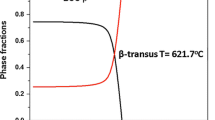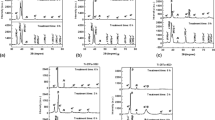Abstract
The microstructural evolution and attendant strengthening mechanisms in two biocompatible alloy systems, the binary Ti-15Mo and the quaternary Ti-13Mo-7Zr-3Fe (TMZF), have been compared and contrasted in this paper. In the homogenized condition, while the Ti-15Mo alloy exhibited a single phase microstructure consisting of large β grains, the TMZF alloy exhibited a microstructure consisting primarily of a β matrix with grain boundary α precipitates and a low volume fraction of intra-granular α precipitates. On ageing the homogenized alloys at 600 ∘C for 4 h, both alloys exhibited the precipitation of refined scale secondary α precipitates homogeneously in the β matrix. However, while the hardness of the TMZF alloy marginally increased, that of the Ti-15Mo alloy decreased substantially as a result of the ageing treatment. In order to understand this difference in the mechanical properties after ageing, TEM studies have been carried out on both alloys in the homogenized and homogenized plus aged conditions. The results indicate that the ω precipitates dissolve on ageing in case of the Ti-15Mo alloy, consequently leading to a substantial decrease in the hardness. In contrast, the ω precipitates do not dissolve on ageing in the TMZF alloy and the precipitation of the fine scale secondary α leads to increased hardness.
Similar content being viewed by others
References
M. J. LONG and H. J. RACK, Biomater. 19 (1998) 1621.
E. W. LOWMAN, J. Amer. Med. Acad. 157 (1955) 487.
K. WANG, Mater. Sci. and Eng. A213 (1996) 134.
C. M. LEE, W. F. HO, C. P. JU and J. H. CHERN LIN, J. Mater. Sci. Mater. Med. 13 (2002) 695.
M. F. SEMLITSCH, H. WEBER, R. M. STREICHER and R. SCHÖN, Biomater. 13(11) (1992) 781.
K.-H. BOROWY and K.-H. KRAMMER, “On the Properties of a New Titanium Alloy (Ti-5Al-2.5Fe) as Implant Material,” Titanium 84’: Science and Technology, Vol. 2 Munich, Deutsche Gesellschaft Für Metallkunde EV (1985) p. 1381.
S. G. STEINEMANN, “Corrosion of Surgical Implants–-in vivo and in vitro Tests,” Evaluation of Biomaterials, edited by G. D. Winter, J. L. Leray and K. de Groot (Wiley, New York, 1980).
S. G. STEINEMANN, “Corrosion of Titanium and Titanium Alloys for Surgical Implants,” Titanium 84’: Science and Technology, Vol. 2 Munich, Deutsche Gesellschaft Für Metallkunde EV, (1985) p. 1373.
S. RAO, T. USHIDA, T. TATEISHI, Y. OKAZAKI and S. ASAO, Bio-med. Mater. Eng. 6 (1996) 79.
P. R. WALKER, J. LEBLANC and M. SIKORSKA, Biochemistry 28 (1990) 3911.
E. CHEAL, M. SPECTOR and W. HAYES, J. Orthop. Res. 10 (1992) 405.
P. PRENDERGAST and D. TAYLOR, J. Biomed. Eng. 12(5) (1990) 379.
W. F. HO, C. P. JU and J. H. CHERN LIN, Biomater. 20 (1999) 2115.
K. WANG, L. GUSTAVSON and J. DUMBLETON, “The Characterization of Ti-12Mo-6Zr-2Fe. A New Biocompatible Titanium Alloy Developed for Surgical Implants,” Beta Titanium in the 1990’s (The Mineral, Metals and Materials Society, Warrendale, Pennsylvania, 1993) p. 2697.
S. G. STEINEMANN, P.-A. MÄUSLI, S. SZMUKLER-MONCLER, M. SEMLITSCH, O. POHLER, H. -E HINTERMANN and S.-M. PERREN, “Beta-Titanium Alloy for Surgical Implants,” Beta Titanium in the 1990’s (The Mineral, Metals and Materials Society, Warrendale, Pennsylvania, 1993) p. 2689.
J. C. FANNING, “Properties and Processing of a New Metastable Beta Titanium Alloy for Surgical Implant Applications: TIMETALTM 21SRx,” Titanium 95’: Science and Technology (1996) p. 1800.
A. K. MISHRA, J. A. DAVIDSON, P. KOVACS and R. A. POGGIE, “Ti-13Nb-13Zr: A New Low Modulus, High Strength, Corrosion Resistant Near-Beta Alloy for Orthopaedic Implants,” Beta Titanium in the 1990’s (The Mineral, Metals and Materials Society, Warrendale, Pennsylvania, 1993) p. 61.
T. A. AHMED, M. LONG, J. SILVERSTRI, C. RUIZ and H. J. RACK, “A New Low Modulus Biocompatible Titanium Alloy,” Titanium 95’: Science and Technology, 1996) p. 1760.
K. WANG, Mater. Sci. Eng. A 213 (1996) 134.
A. K. BOWEN, Scripta Metall. 5 (1971) 709.
A. K. BOWEN, “On the Strengthening of Metastable β-Titanium Alloy by ω- an α-Precipitation,” Titanium’80 Science and Technology, in Proceedings of the Fourth International Conference on Titanium, Kyoto, Japan, 1980) p. 1317.
J. C. WILLIAMS, B. S. HICKMAN and D. H. LESLIE, Metall. Trans. 2 (1971) 477.
Author information
Authors and Affiliations
Rights and permissions
About this article
Cite this article
Nag, S., Banerjee, R., Stechschulte, J. et al. Comparison of microstructural evolution in Ti-Mo-Zr-Fe and Ti-15Mo biocompatible alloys. J Mater Sci: Mater Med 16, 679–685 (2005). https://doi.org/10.1007/s10856-005-2540-6
Received:
Accepted:
Issue Date:
DOI: https://doi.org/10.1007/s10856-005-2540-6




